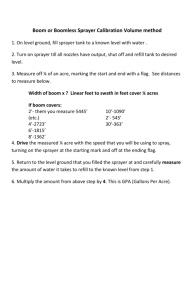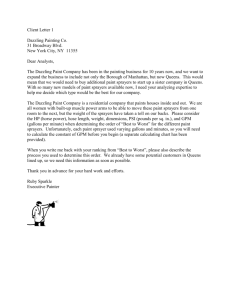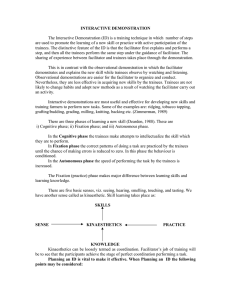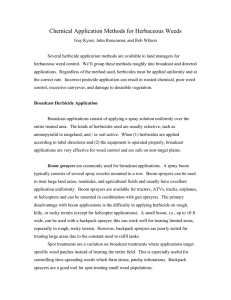Sprayers and Other Equipment for Orchard Maintenance
advertisement
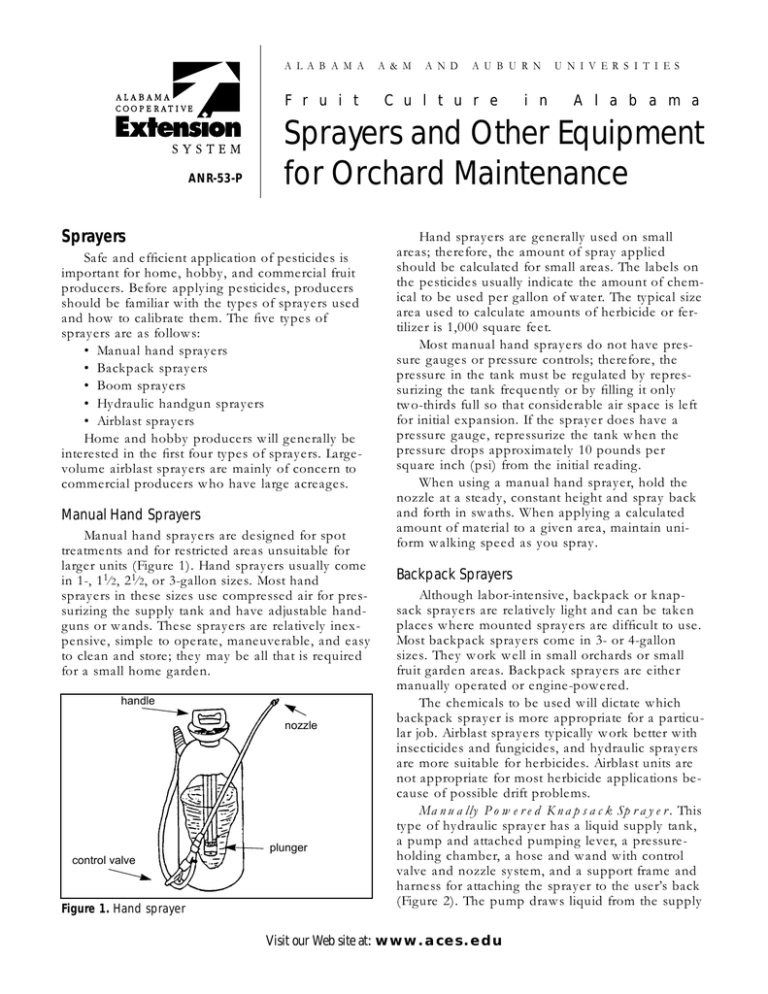
A L A B A M A F r u i t ANR-53-P Safe and efficient application of pesticides is important for home, hobby, and commercial fruit producers. Before applying pesticides, producers should be familiar with the types of sprayers used and how to calibrate them. The five types of sprayers are as follows: • Manual hand sprayers • Backpack sprayers • Boom sprayers • Hydraulic handgun sprayers • Airblast sprayers Home and hobby producers will generally be interested in the first four types of sprayers. Largevolume airblast sprayers are mainly of concern to commercial producers who have large acreages. Manual Hand Sprayers Manual hand sprayers are designed for spot treatments and for restricted areas unsuitable for larger units (Figure 1). Hand sprayers usually come in 1-, 11⁄ 2, 21⁄ 2, or 3-gallon sizes. Most hand sprayers in these sizes use compressed air for pressurizing the supply tank and have adjustable handguns or wands. These sprayers are relatively inexpensive, simple to operate, maneuverable, and easy to clean and store; they may be all that is required for a small home garden. handle nozzle plunger Figure 1. Hand sprayer A N D A U B U R N C u l t u r e i n U N I V E R S I T I E S A l a b a m a Sprayers and Other Equipment for Orchard Maintenance Sprayers control valve A & M Hand sprayers are generally used on small areas; therefore, the amount of spray applied should be calculated for small areas. The labels on the pesticides usually indicate the amount of chemical to be used per gallon of water. The typical size area used to calculate amounts of herbicide or fertilizer is 1,000 square feet. Most manual hand sprayers do not have pressure gauges or pressure controls; therefore, the pressure in the tank must be regulated by repressurizing the tank frequently or by filling it only two-thirds full so that considerable air space is left for initial expansion. If the sprayer does have a pressure gauge, repressurize the tank when the pressure drops approximately 10 pounds per square inch (psi) from the initial reading. When using a manual hand sprayer, hold the nozzle at a steady, constant height and spray back and forth in swaths. When applying a calculated amount of material to a given area, maintain uniform walking speed as you spray. Backpack Sprayers Although labor-intensive, backpack or knapsack sprayers are relatively light and can be taken places where mounted sprayers are difficult to use. Most backpack sprayers come in 3- or 4-gallon sizes. They work well in small orchards or small fruit garden areas. Backpack sprayers are either manually operated or engine-powered. The chemicals to be used will dictate which backpack sprayer is more appropriate for a particular job. Airblast sprayers typically work better with insecticides and fungicides, and hydraulic sprayers are more suitable for herbicides. Airblast units are not appropriate for most herbicide applications because of possible drift problems. Manually Powered Knapsack Sprayer. This type of hydraulic sprayer has a liquid supply tank, a pump and attached pumping lever, a pressureholding chamber, a hose and wand with control valve and nozzle system, and a support frame and harness for attaching the sprayer to the user’s back (Figure 2). The pump draws liquid from the supply Visit our Web site at: www.aces.edu nozzle harness liquid supply tank control valve pumping lever support frame Figure 2. Backpack sprayer Figure 3. Boom sprayer tank and delivers it to the pressurizing chamber where seals and valves hold the liquid pesticide under pressure until the valve on the wand is opened. The pressurized fluid passes through a small orifice on the spray nozzle and is broken into small spray droplets. As the pressurized flow continues, the pressure in the tank drops and must be reestablished by hand-pumping the pumping lever. Although most hydraulic knapsack sprayers are manually operated, they can also be engine-powered. A manual knapsack sprayer can be a fairly accurate unit if it is equipped with a pressure gauge or pressure regulator because it can apply a predetermined amount of chemical to a specific area. The nozzle or nozzles (on a hand boom) can be calibrated for set conditions. Engine-Powered Backpack Mist Blower. The backpack mist blower is a small airblast sprayer. Because air is the carrier, instead of water as in the hydraulic sprayer, the airblast units have advantages over hydraulic units in labor and coverage. In the airblast unit, only a small amount of water is needed to prepare the spray mix, so there is much less water to carry per acre. The airblast sprayer also gives better coverage because the air turbulence provides superior leaf coverage. This is because the mist-laden air being forced into the plant freely moves in every direction within the plant canopy, whereas the stream from a hydraulic sprayer mainly wets only leaves in line with the direction of spray. ward and over the crop (Figure 3). They can also be used in maintaining the floor of orchards where herbicides can eliminate or control the growth of ground cover on the orchard floor. Boom sprayers can be tractor-mounted or self-propelled. Tractor or Prime-Mover-Mounted Sprayer. Boom sprayers can be mounted on a frame that attaches to a tractor by a three-point hitch system, or they can be attached or mounted to a four-wheeler. The sprayer can be run by an electric pump that is powered by the four-wheeler’s battery or by a separate battery. Trailer-Mounted Sprayer. Boom sprayers can also be supported by wheels and towed by a tractor, four-wheeler, or garden tractor. This sprayer is advantageous for the farmer who has small equipment because a larger tank of spray mix can be towed safely. The boom is mounted on the rear of the trailer frame. The pump can be powered by the tractor power takeoff (PTO) or by a gasoline engine mounted on the trailer. Skid-Mounted Sprayer. A sprayer mounted on a skid frame can be carried in a pickup truck or placed on a trailer. This type of sprayer usually has a tank, engine, and boom. The boom can be mounted on the skid or on the rear of the pickup or trailer. Self-Propelled, High-Clearance Sprayer. This sprayer is commonly used in vegetable production (sweet corn) or cotton production where it is important that the machine clears a relatively high-growing crop. This type of sprayer probably would not be a first choice for small orchard crops. Boom Sprayers Boom sprayers are commonly used for lowgrowing crops because the boom can extend out2 Table 1. Guidelines For Selecting Hydraulic Handgun Sprayers. Tree Height (feet) Pump Size (gpm) Up to 15 Up to 25 20 to 35 30 to 45 3 5 10 15 Pump Pressure 100-foot hose (psi) 400 400 400 400 Hose Nozzle Diameter Pressure (inches) (psi) 3⁄ 8 3⁄ 8 1⁄ 2 1⁄ 2 150 250 300 300 to to to to 200 300 350 350 Airblast Sprayers Airblast sprayers use a high-velocity, large-volume airstream to apply a concentrated pesticide mixture (Figure 5). Small, tractor-mounted airblast sprayers are available and may be adequate for small acreage and small- to medium-sized trees. Airblast sprayers can be one-way (one-sided) or two-way (two-sided). Figure 4. Hydraulic handgun sprayer Hydraulic Handgun Sprayers Hydraulic handgun sprayers are hand-held gun sprayers that can spray pesticide into the tops of fruit and shade trees (Figure 4). Water is used as both the diluent and the carrier. The sprayer must provide and maintain high pressure and sufficient flow of liquid so that the large droplets of the stream can reach the tops of the trees. Although handgun sprayers are primarily used for spraying trees, they can be used on small fruit on a limited basis and may be used in combination with a boom sprayer. A directional-control valve can be used on a boom sprayer to direct the flow from the boom to a handgun; then the boom sprayer can be used as a handgun sprayer for small fruits. A multiple-outlet gun creates a small boom for small fruit. A variable-discharge-angle gun allows the spray angle to be controlled from a wide-angle spray for short trees and shrubs to a narrow stream for tall trees. The handle of the gun can be twisted to control the spray angle. Hydraulic handgun sprayers differ in construction to satisfy the different kinds of tasks for which they are used. Typically, piston pumps are used to achieve the high pressures required. Since piston pumps are commonly low flow, large pumps are needed to reach tall trees. Table 1 lists the pump pressure and flow characteristics needed to deliver spray to trees of different heights. Note the decrease in pressure caused by friction in small-diameter hoses. Figure 5. Airblast sprayer The goal of airblast spraying is to replace the air contained in the tree with spray-ladened air. High air volume capacity in the blower and the correct travel speed are important factors in achieving this. Travel speed must be slow enough to create air momentum to penetrate the plant canopy. Velocity is important for getting the spray to the top of the trees or across a field. Most airstreams lose 75 percent of their velocity in the first 25 feet from the sprayer. Airblast sprayers can spray an area in less time than either handgun or boom sprayers can. However, airblast sprayers require more power than boom or handgun sprayers do. Because airblast sprayers apply a concentrated pesticide mixture, a much smaller amount of water is used in comparison to the amount used in hydraulic or boom sprayers. Pesticide drift can be a serious problem since airblast sprayers are broadcast sprayers. 3 Sprayer Calibration Other Equipment and Supplies Procedures for calibrating the different types of sprayers and more detailed explanations of their working parts can be found in the following publications: Extension publication ANR-570, “Equipment and Calibration for Low-Pressure Ground Sprayers;” Extension publication ANR-618, “Orchard Spraying with an Air-Blast Sprayer;” and Extension publication ANR-744, “Calibrating a Manual Sprayer.” See Extension publication ANR-50, “Spraying Home Orchards,” for information on mixing pesticides, sprayer care, and pesticide precautions. In addition to spray equipment, other equipment and supplies are needed for pruning, training, cultivating, mowing, and harvesting. The specific equipment needs for home, hobby, and commercial orchards will vary depending on the size of orchards, the type of fruit grown, and the availability of equipment from other farming operations. Pruning Tools and Spreading Supplies Small hand pruners can be used for most pruning cuts during the first or second year. Lopping shears will be needed to cut branches from to 3⁄ 4 to 11⁄ 2 inches in diameter. For larger cuts, a pruning saw is best. Pole pruners and pole pruning saws are useful for pruning large trees—a combination of the two is available at most orchard supply stores. Some of the finer orchard pruning equipment is imported and may only be available from certain orchard supply houses. Clothespins, round toothpicks, and limb spreaders are needed during the tree training period for apples and pears. Limb spreaders can be made by cutting No. 9 clothesline wire into various lengths. Wooden and plastic limb spreaders are also available commercially. Sprayer Selection Selecting which sprayer to use is not always easy. Powered and manual sprayers are available in sizes appropriate for small orchards and farms. When considering the type of sprayer for your operation, keep in mind the various uses you may have for the sprayer. • Is the planting small enough to be covered using a manual sprayer? • Will a boom sprayer be adequate for low fruit crops and the orchard floor? • Are there other crops on the farm for which a boom sprayer can be used, such as vegetables, grain, or pasture? • Will a handgun sprayer be needed for spraying a few fruit and shade trees? • Will an airblast sprayer with attachments be needed to cover both orchard and ground crops? You should also consider how you will move and power your sprayer. • What size tractor or truck do you have, or what size will you need to purchase? Will the truck or tractor that moves the sprayer also power the sprayer? If not, you may need to purchase a separate engine to operate the sprayer. • Will you be using other types of primary power equipment such as a four-wheeler or a large garden tractor? • Will the primary power equipment have PTO capability? If not, your sprayer cannot be PTOpowered. For many home fruit plantings, a small, gasoline-powered hydraulic handgun sprayer with a 10to 50-gallon tank will be quite adequate for insect, mite, and disease problems. Spray pressures of 50 to 100 psi are adequate for many fruit plantings, although taller, larger trees may require a minimum of 100 to 200 psi for best results. A manual hand sprayer may also be needed for small, select spraying activities. Cultivators and Mowers Most orchard floors have some type of vegetative cover, usually grass. This vegetation may cover the entire orchard floor, or it may cover an area between the rows (row middle), with the area the length of the tree rows (row strip) being mulched or bare. The growth of vegetation must be controlled both in the row strips and row middles. In larger commercial operations, vegetation in the row strips is controlled by spraying chemicals, mulching, or cultivating. Vegetation in the row middles is usually controlled by mechanical or chemical mowing. In most home fruit gardens, weeds on the orchard floor between rows are controlled by mechanical mowing (Figure 6). Broadleaf weeds and grasses in the row strips (along and around the plants) are most often managed by limited chemical treatment with safe herbicides, mechanical tillage or hoeing, hand pulling, or mulching. In most cases, a combination of these control measures is used. To avoid damaging plant roots, special care must be taken when using tractor-mounted or hand-operated tillage equipment. Typically, the depth of tillage in row strips should not exceed 1 to 2 inches. It is best to avoid using tillage around tree fruits and especially in the fall and winter months. 4 bare row strip grass Figure 6. Mechanized tiller used to cultivate bare row strip (Figure 7). These aids would be valuable to large hobby or small commercial producers. Mechanical harvesters are also available for large commercial acreages of blueberries. The harvesters are pulled or driven over the row. Mechanical harvesters range in size from a threepoint hitch mount to a pull-type or a self-propelled harvester. Harvesting Aids Most fruit in Alabama is harvested by hand. Some tree-fruit crops have been developed on trellises so that harvesting by hand is relatively easy. Harvesting aids have also been developed to assist in harvesting. One small-fruit crop on which harvesting aids are used is blueberries. The harvesting aids consist of a catch frame, vibrator, and power source Figure 7. Catch frame and electric vibrator: harvest aid for blueberries 5 Cooling Facilities Cooling facilities can be either a portable or a small stationary structure with some type of room for forced-air cooling (Figure 8). If cooling facilities are not available, fruit can be cooled in a basement or cellar. Figure 8. Cooling facility used by small orchard operators Arlie Powell, Extension Horticulturist, Professor, Horticulture, David Himelrick, Extension Horticulturist, Professor, Horticulture, and Charles Ogburn, former Extension Agricultural Engineer, all at Auburn University For more information, call your county Extension office. Look in your telephone directory under your county’s name to find the number. ANR-53-P Issued in furtherance of Cooperative Extension work in agriculture and home economics, Acts of May 8 and June 30, 1914, and other related acts, in cooperation with the U.S. Department of Agriculture. The Alabama Cooperative Extension System (Alabama A&M University and Auburn University) offers educational programs, materials, and equal opportunity employment to all people without regard to race, color, national origin, religion, sex, age, veteran status, or disability. UPS, 7.7M13, New July 1999, ANR-53-P
